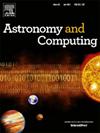Encapsulating textual contents into a MOC data structure for advanced applications
IF 1.8
4区 物理与天体物理
Q2 ASTRONOMY & ASTROPHYSICS
引用次数: 0
Abstract
Context:
The Multi-Order Coverage map (MOC) is a widely adopted standard promoted by the International Virtual Observatory Alliance (IVOA) to support data sharing and interoperability within the Virtual Observatory (VO) ecosystem. This hierarchical data structure efficiently encodes and visualizes irregularly shaped regions of the sky, enabling applications such as cross-matching large astronomical catalogs, visualizing multi-wavelength and multi-messenger surveys, and facilitating collaborative research through seamless interoperability in big-data-driven exploration.
Aims:
This study aims to explore potential enhancements to the MOC data structure by encapsulating textual descriptions and semantic embeddings into sky regions. Specifically, we introduce “Textual MOCs”, in which textual content is encapsulated, and “Semantic MOCs” that transform textual content into semantic embeddings. These enhancements are designed to enable advanced operations such as similarity searches and complex queries and to integrate with generative artificial intelligence (GenAI) tools to improve context-aware interactions and response accuracy in astronomical data analysis, and support agent-based applications.
Method:
We experimented with Textual MOCs by annotating detailed descriptions directly into the MOC sky regions, enriching the maps with contextual information suitable for interactive learning tools. For Semantic MOCs, we converted the textual content into semantic embeddings, numerical representations capturing textual meanings in multidimensional spaces, and stored them in high-dimensional vector databases optimized for efficient retrieval.
Results:
The implementation of Textual MOCs enhances user engagement by providing meaningful descriptions within sky regions, facilitating the development of effective game-based learning. Semantic MOCs enable sophisticated query capabilities, such as similarity-based searches and context-aware data retrieval, enhancing astronomical data analyses. Integration with multimodal generative AI systems allows for more accurate and contextually relevant interactions supporting both spatial, semantic and visual operations for advancing astronomical data analysis capabilities. Through straightforward examples, we discuss the fundamentals of this new experimental implementation.
将文本内容封装到高级应用程序的MOC数据结构中
背景:多阶覆盖图(MOC)是国际虚拟天文台联盟(IVOA)为支持虚拟天文台(VO)生态系统内的数据共享和互操作性而推广的一种被广泛采用的标准。这种分层数据结构有效地对天空不规则形状的区域进行编码和可视化,使大型天文目录交叉匹配、多波长和多信使巡天可视化等应用成为可能,并通过大数据驱动探索中的无缝互操作性促进协作研究。目的:本研究旨在通过将文本描述和语义嵌入封装到天空区域中,探索对MOC数据结构的潜在增强。具体来说,我们引入了“文本moc”,其中文本内容被封装,以及“语义moc”,将文本内容转换为语义嵌入。这些增强功能旨在实现高级操作,如相似性搜索和复杂查询,并与生成式人工智能(GenAI)工具集成,以提高天文数据分析中的上下文感知交互和响应准确性,并支持基于代理的应用程序。方法:我们对文本MOC进行了实验,直接在MOC天空区域中注释详细的描述,丰富了适合交互式学习工具的上下文信息。对于语义moc,我们将文本内容转换为语义嵌入,在多维空间中捕获文本含义的数字表示,并将其存储在优化的高维矢量数据库中,以实现高效检索。结果:文本moc的实现通过在天空区域内提供有意义的描述来增强用户参与度,促进了有效的基于游戏的学习的发展。语义moc支持复杂的查询功能,如基于相似性的搜索和上下文感知的数据检索,增强天文数据分析。与多模态生成人工智能系统的集成允许更准确和上下文相关的交互,支持空间、语义和视觉操作,以提高天文数据分析能力。通过简单的例子,我们讨论了这个新的实验实现的基本原理。
本文章由计算机程序翻译,如有差异,请以英文原文为准。
求助全文
约1分钟内获得全文
求助全文
来源期刊

Astronomy and Computing
ASTRONOMY & ASTROPHYSICSCOMPUTER SCIENCE,-COMPUTER SCIENCE, INTERDISCIPLINARY APPLICATIONS
CiteScore
4.10
自引率
8.00%
发文量
67
期刊介绍:
Astronomy and Computing is a peer-reviewed journal that focuses on the broad area between astronomy, computer science and information technology. The journal aims to publish the work of scientists and (software) engineers in all aspects of astronomical computing, including the collection, analysis, reduction, visualisation, preservation and dissemination of data, and the development of astronomical software and simulations. The journal covers applications for academic computer science techniques to astronomy, as well as novel applications of information technologies within astronomy.
 求助内容:
求助内容: 应助结果提醒方式:
应助结果提醒方式:


